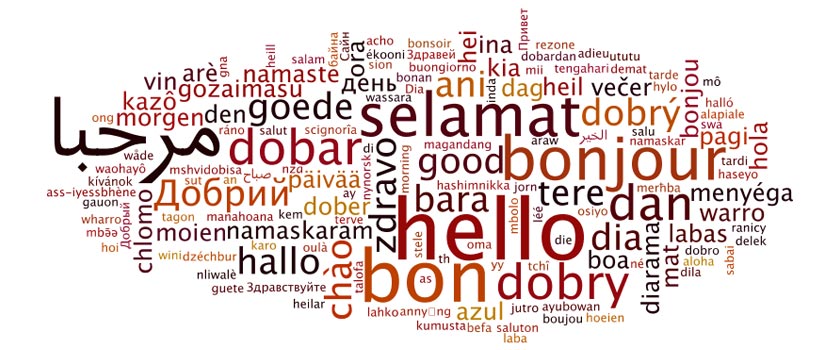Most Spoken Languages in Asia
By: Ricky vela Posted on Mon, 04-06-2018

Learning a new language is a skill in itself. With all the hype about the importance of learning new languages, it is no surprise that more people are jumping on the bandwagon to add new languages to their portfolios, and some areas are a breeding ground for a number of diverse languages. The Asian region, for example, known widely as the APAC (Asia Pacific) is home to a mind-boggling 2197 languages.
This just goes to show how even a single continent can contain so many languages in its fold.
There are more than 4.3 billion people speaking nearly 2,197 living languages across Asia. Some of these languages are related to each other while others have roots deep in the old ages.
But which of the languages are the most spoken languages in Asia?
Let’s take a look at the most widely spoken languages and the contribution of each language in the APAC language pool.
Chinese Mandarin:
You may all have heard about Chinese Mandarin, the widest spoken language in the Asian region and the language of China, the leader of APAC countries. It is spoken by approximately 1,200,000,000 speakers—a 51% chunk of Asia. Mandarin is one that does not miss any list of useful and most popular languages—without fail!
This popularity of Mandarin is mainly due to the huge economic shifts experienced by China in the last few decades that have put this language on the face of Asia’s most popular languages. Considering the quantum leaps this language is making, it is easy to believe analysts estimate that China will become a leading economy by the year 2050.
English:
English, the official and business language of the world is a lingua franca of not only the United States and England, but it is also spoken widely in the Asia Pacific region. In fact, English occupies the second slot in the most spoken languages in Asia with 400,000,000 people speaking English. That is roughly 17% of the population. To say that English is the “language of the globe” would be an understatement. English is the head of languages after Mandarin and is likely to occupy the same spot in the future as well.
Indonesian:
The Indonesian language may come across as a not-so-popular candidate in the line of languages but it occupies third place in the most spoken languages of the Asia region. Spoken by 240,000,000 people, Indonesian is the language of 10% of the total Asian population. Being a standardized form of Malay, the Indonesian language is bound to flourish with changing times.
Japanese:
Japanese is another contender for the most spoken languages of Asia with 120,000,000 speakers that constitute about 5% of the total population. The Japanese economy is well-known for its advancements in the field of science and information technology. Considering this aspect, the Japanese have secured a comfortable niche in the Asian market and is likely to be the same in the future.
Filipino:
Filipino, historically taking its roots from the Tagalog language, is the official language of the Philippines and adjoining areas. It is spoken by 4% of Asia or 90,000,000 people and is a language with a rapidly-growing influence in the learning and education sector.
Korean and Vietnamese:
The reason these two languages have been mentioned in a combined way is that both are spoken by approximately 80,000,000 speakers or 3% of the total Asian population. Although a small figure in comparison to other languages, Korean and Vietnamese are likely to flourish in the coming days due to the strong influence of Korea and Vietnam.
Thai:
Thai central, Siamese, as it is commonly known is the national and official language of Thailand and the first language of the majority of Thai people. In Asia, it is spoken by some 60,000,000 speakers who constitute 2% of the total population.
Burmese and Malaysian:
Burmese and Malaysian languages constitute the lowest spot in the list of most spoken languages in the Asia region with less than 30,000,000 speakers that are approximately 1% of the total Asian population. The reason for this size is simple—the small size of the Malaysian and Burmese regions.
The Asian Language Pool:
Although there are many languages spoken around the world, the Asian region is home to a number of diverse languages that are likely to flourish and spread with the rise of immigration and the lowering of the trade barriers between nations and countries. It will not be long before these Asian languages dominate the world with Chinese Mandarin leading the way along with English and Indonesian. The key to gaining a strong business footing in Asia is to be aware of the importance, and vitality of these languages for business growth.
Read More: Learn Japanese Language

Africa is the second largest and second most populous continent. As recent statistics suggest, 1,486,275,887 is the current population of
Read more
dxf: DXF is a CAD data file format developed by Autodesk for CAD data exchange between AutoCAD and other software. docx:
Read more
Mars Translation can help you extract the texts in a DXF file and convert them into a XML file so
Read more
Mars Translation can help you extract the texts in a DWG file and convert them into a Word file so
Read more
No state on the western side of the globe can compare the strategic geographic location, diverse multilingual workforce, and attention
Read more
San Diego is California's second-largest city, and it has a population of 1.3 million from which three million residents are
Read more
Dallas is the largest state in Texas after Houston and San Antonio. It is the ninth most populous city in
Read more
In this day and age, users love to consume video content. Statistics show that almost 90% of all internet users
Read more
Virtual reality is transforming our imaginative worlds into existence. Since childhood, we used to create visionary kingdoms and act like
Read more